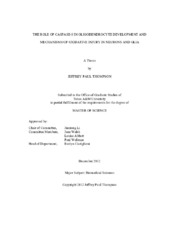| dc.description.abstract | Apoptosis is essential not only to the normal development of a multicellular organism but also for the maintenance of tissue homeostasis. This proposal seeks to investigate, in part, the role of oligodendrocyte (OL) apoptosis in myelination. We used an OL-specific conditional knockout animal to study caspase-8 function in OL development; analyzing histological differences in myelination at postnatal day 10 and alterations to OL proliferation, differentiation, and cell death in culture. Our preliminary data suggests that deletion of caspase-8 did not alter OL proliferation or differentiation in culture, but reduced the percentage of apoptotic cells following nutrient deprivation. In vivo, we found an increase in myelinated axons in the spinal cord of caspase-8 deficient mice, indicating a role for caspase-8 in the myelination process.
This study also seeks to investigate mechanisms of cell death in OLs, astrocytes, and neurons following oxidative injury. Exposure of primary OLs, astrocytes, and neurons to arachidonic acid (AA) resulted in oxidative stress and cell death. Necrostation-1, the specific inhibitor of receptor interacting protein kinase 1 (RIP-1), markedly prevented AA-induced oxidative death in OLs and astrocytes, but not in neurons. Similarly, we found that blockade of 12-lipoxygenase (LOX) and c-Jun N-terminal kinase (JNK) protected OLs and astrocytes but not neurons against AA toxicity. Consistent with the inability of necrostatin-1 to rescue neurons, we found very low expression of RIP-1 as well as RIP-3 in neurons. Finally, the zinc chelator TPEN effectively abolished AA-induced oxidative death in all three cell types, suggesting zinc release as a common mechanism. Taken together, our findings indicate differences in cell death mechanisms following oxidative injury in astrocytes, OLs, and neurons. | en |


